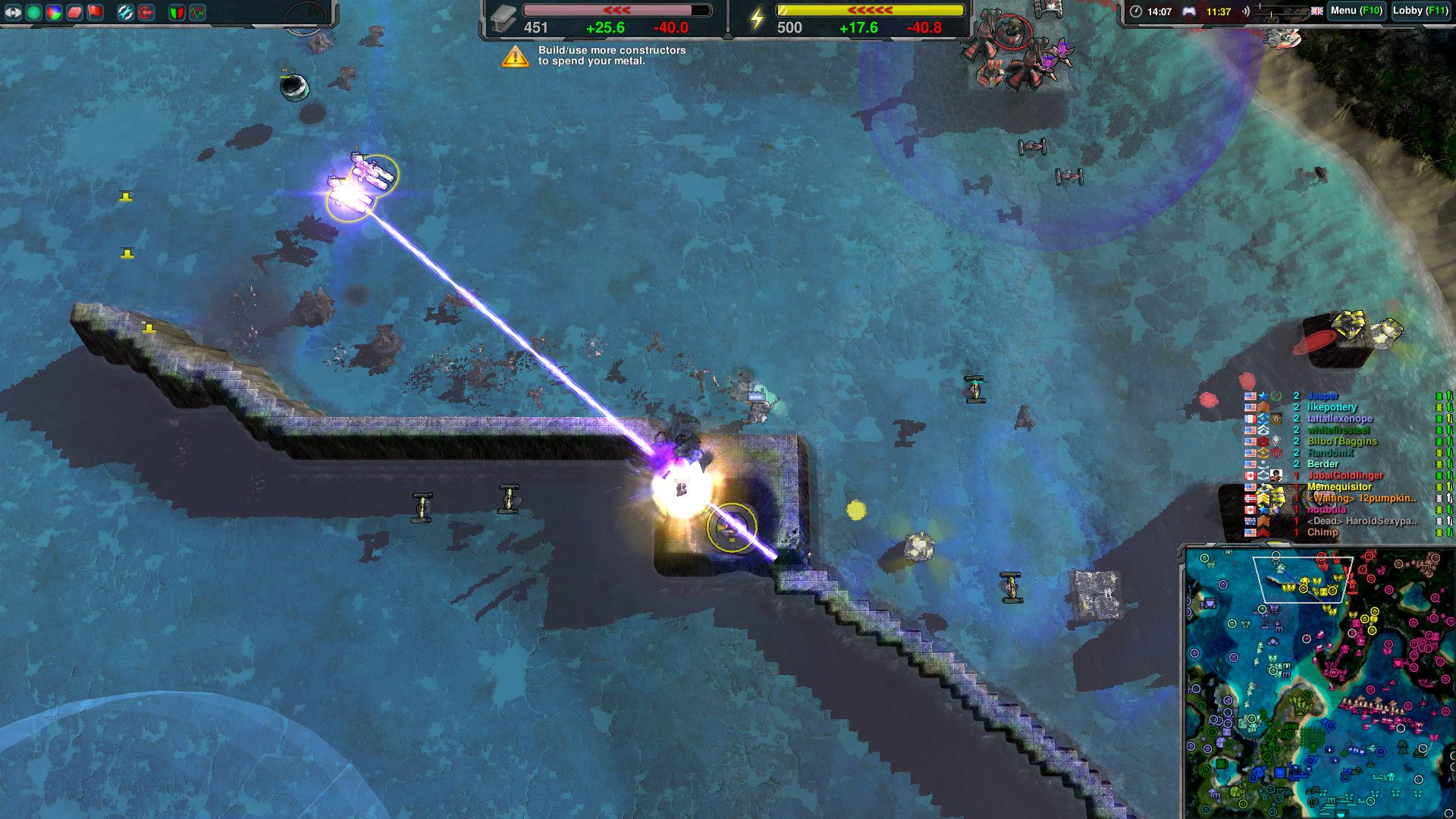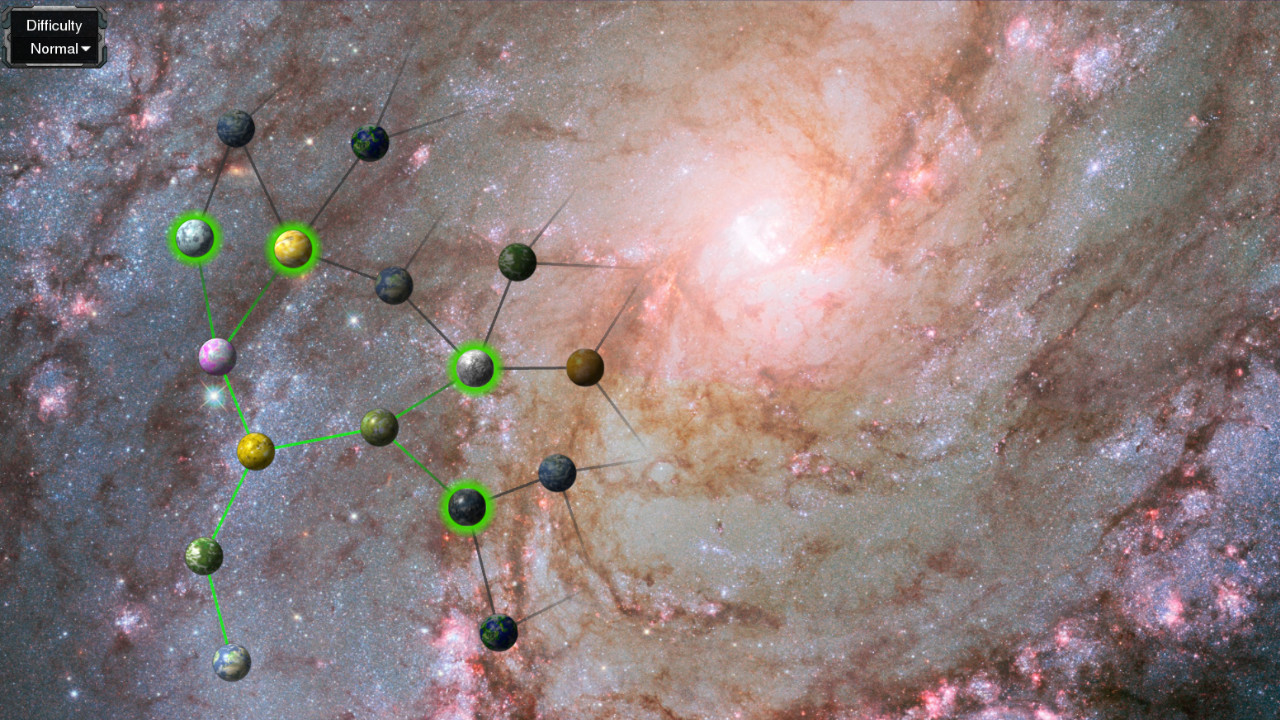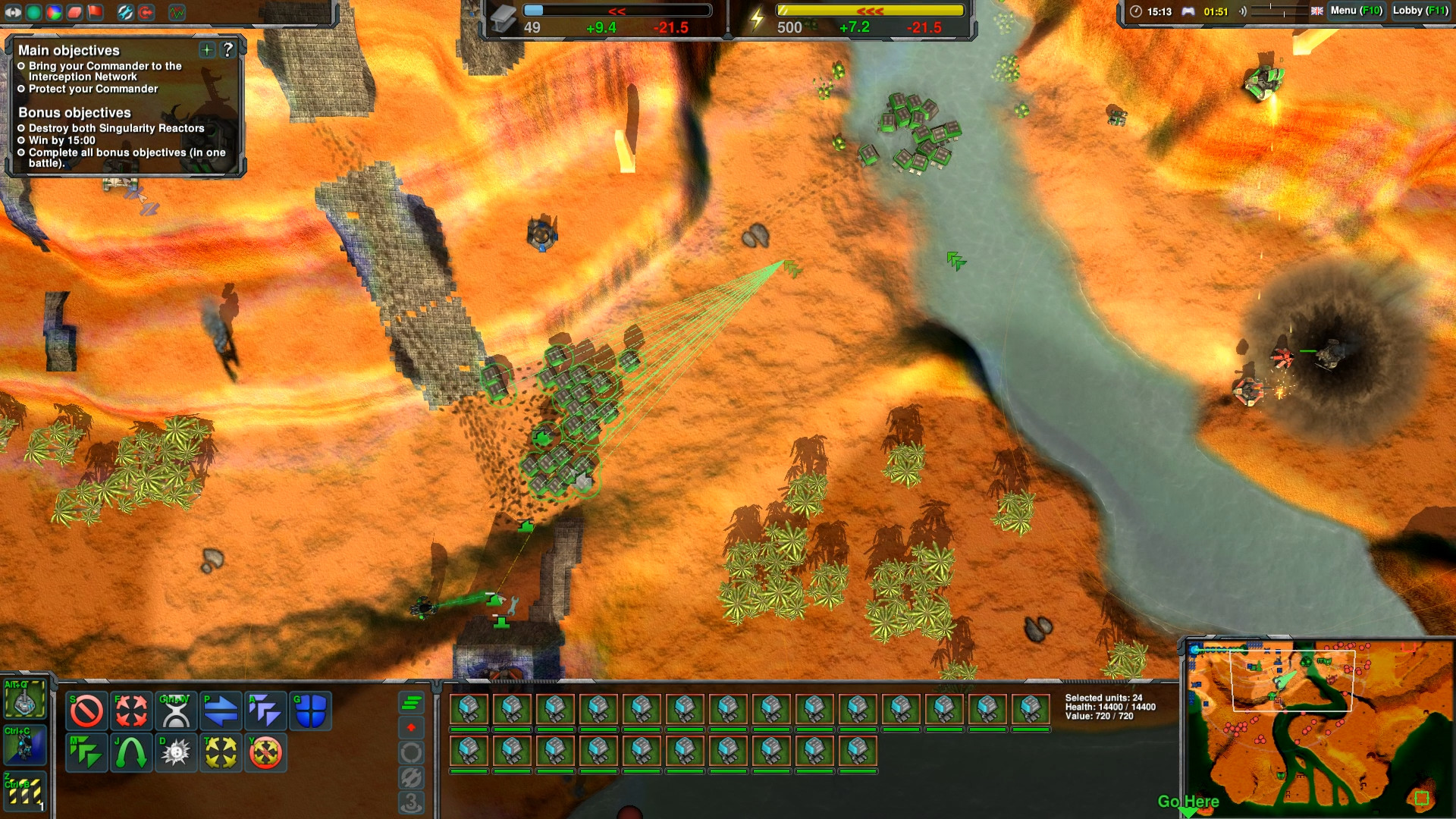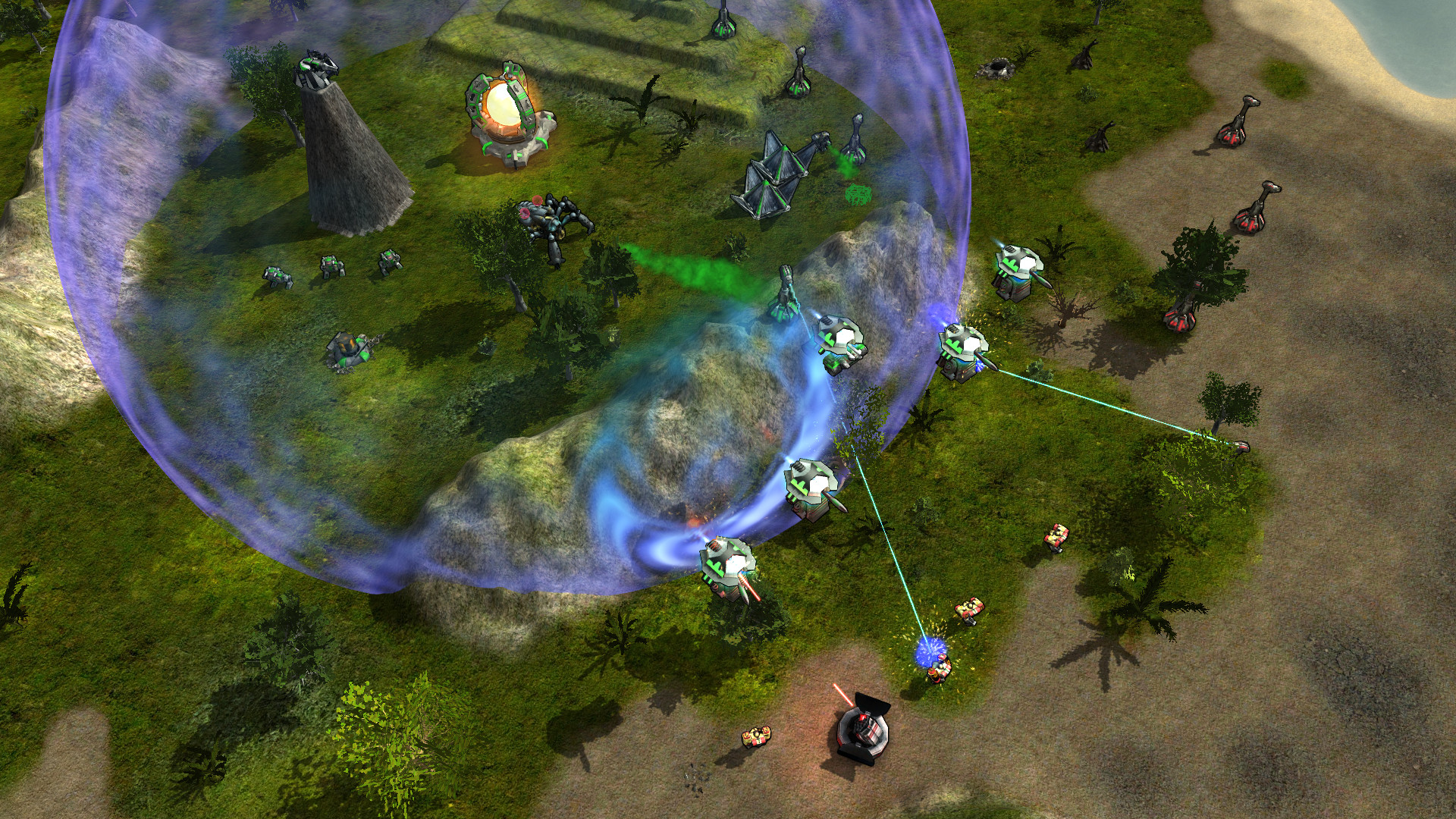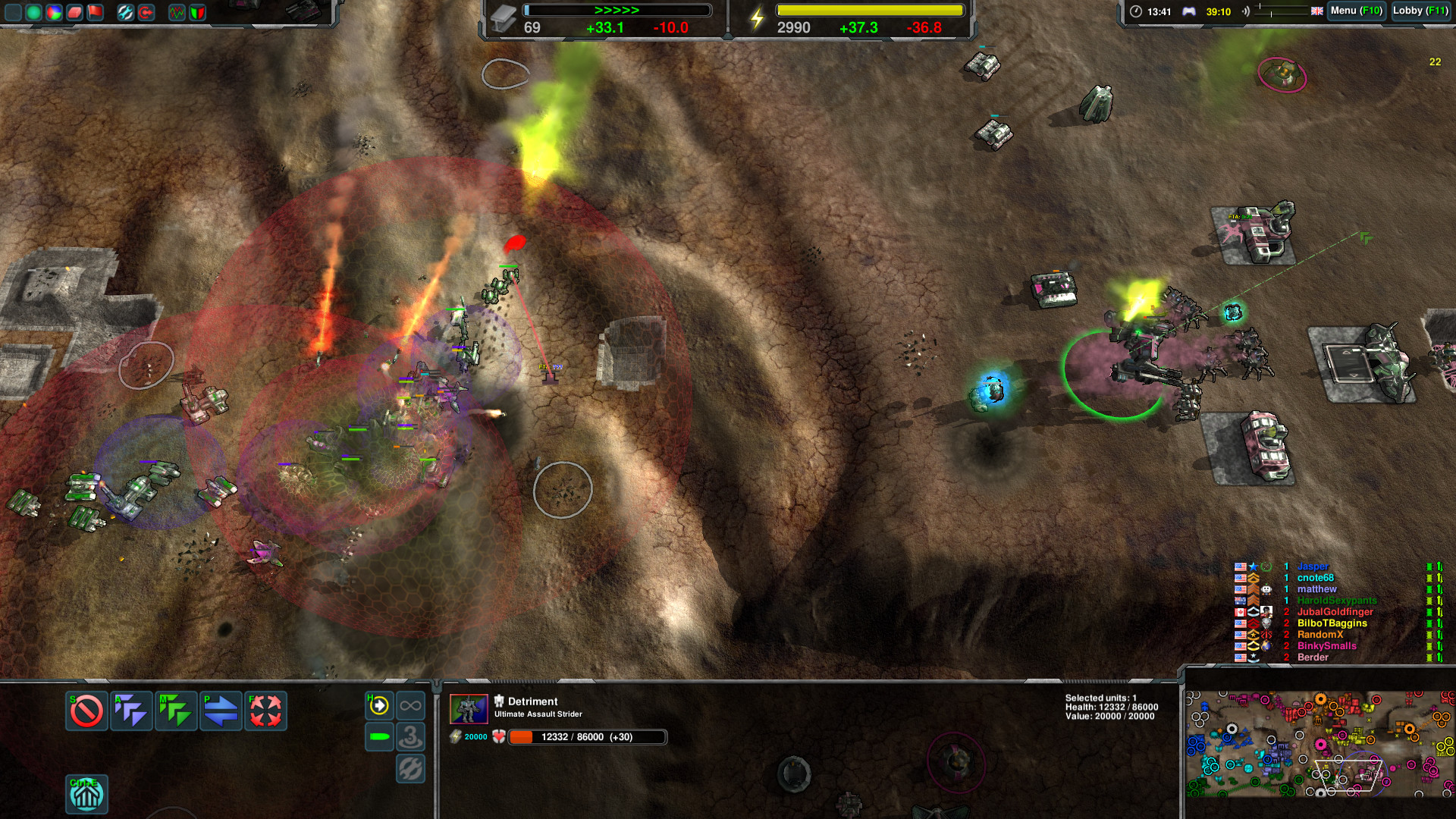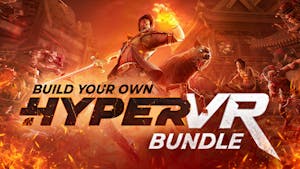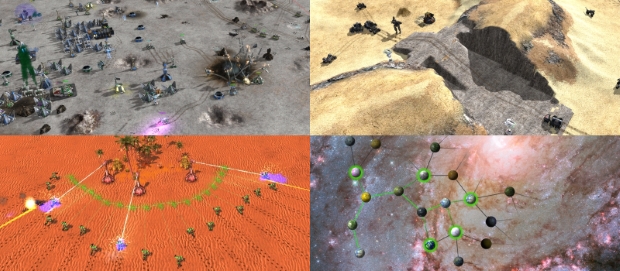
Commander wanted! Construct giant robots, build an army of a thousand Fleas. Move mountains if needed. Bury the enemy at all cost!
- Traditional real time strategy with physically simulated units and projectiles.
- 100+ varied units with abilities including terrain manipulation, cloaking and jumpjets.
- 70+ mission galaxy-spanning campaign to be enjoyed solo or co-op with friends.
- Challenging, (non-cheating) skirmish AI and survival mode.
- Multiplayer 1v1 - 16v16, FFA, coop. ladders, replays, spectators and tournaments.
- PlanetWars - A multiplayer online campaign planned to start in May.
- Really free, no paid advantages, no unfair multiplayer.
Fully Utilized Physics
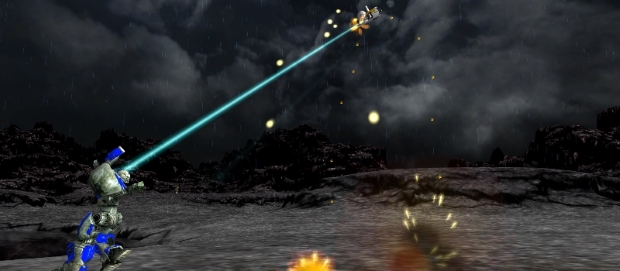
Simulated unit and projectile physics is used to a level rarely found in a strategy game.
- Use small nimble units to dodge slow moving projectiles.
- Hide behind hills that block weapon fire, line of sight and radar.
- Toss units across the map with gravity guns.
- Transport a battleship to a hilltop - for greater views and gun range.
Manipulate the Terrain
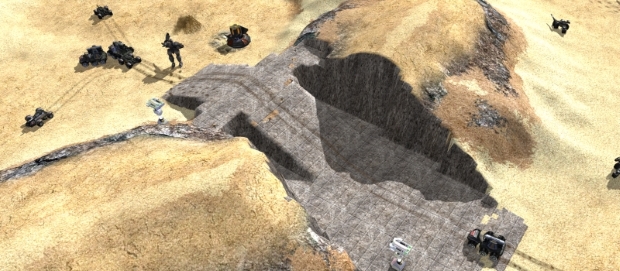
The terrain itself is an ever-changing part of the battlefield.
- Wreck the battlefield with craters that bog down enemy tanks.
- Dig canals to bring your navy inland for a submarine-in-a-desert strike.
- Build ramps, bridges, entire fortress if you wish.
- Burn your portrait into continental crust using the planetary energy chisel.
Singleplayer Campaign and Challenging AI

Enjoy many hours of single player and coop fun with our campaign, wide selection of non-cheating AIs and a survival mode against an alien horde.
- Explore the galaxy and discover technologies in our singleplayer campaign.
- Face a challenging AI that is neither brain-dead nor a clairvoyant cheater.
- Have some coop fun with friends, surviving waves of chicken-monsters.
- Cloaking? Resurrection? Tough choices customizing your commander.
Casual and Competitive Multiplayer
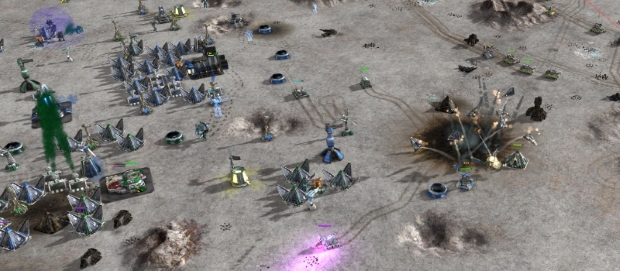
Zero-K was built for multiplayer from the start, this is where you can end up being hooked for a decade.
- Enjoying epic scale combat? Join our 16v16 team battles!
- Looking for a common goal? Fight AIs or waves of chicken-monsters.
- Prefer dancing on a razor's edge? Play 1v1 in ladder and tournaments.
- Comebacks, betrayals, emotions always running high in FFA.
- Want to fight for a bigger cause? Join PlanetWars, a competitive online campaign with web-game strategic elements, diplomacy and backstabbing (currently on hiatus pending an overhaul).
Power to the People

We are RTS players at heart, we work for nobody. We gave ourselves the tools we always wanted to have in a game.
- Do what you want. No limits to camera, queue or level of control.
- Paint a shape, any shape, and units will move to assume your formation.
- Construction priorities let your builders work more efficiently.
- Don't want to be tied down managing every unit movement? Order units to smartly kite, strafe or zig zag bullets.
Plenty of Stuff to Explore (and Explode)
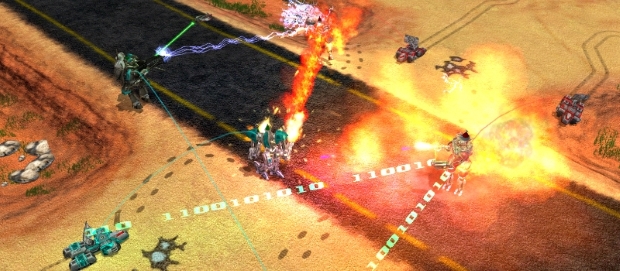
Zero-K is a long term project and it shows, millions hours of proper multiplayer testing and dozens of people contributing ever expanding content.
- Learn to use all of our 100+ units and play on hundreds of maps.
- Invent the next mad team-tactics to shock enemies and make allies laugh.
- Combine cloaking, teleports, shields, jumpjets, EMP, napalm, gravity guns, black hole launchers, mind control and self-replication.
- Tiny flea swarm that clings to walls?
- Jumping "cans" with steam-spike?
- Buoys that hide under water to ambush ships?
- Mechs that spew fire and enjoy being tossed from air transports?
- Carrier with cute helicopters?
- Jumping Jugglenaut with dual wielding gravity guns?
- Meet them in Zero-K!
After a year and a half of posts, the closest one to a factory overview is the post on jumpjets . It is time to change that, so to lay the foundation, we look at how chassis type (bot or vehicle) influences factory design. The factories are the factions of Zero-K, and while each has a unique set of around ten units, there is some consistency to the roles those units take. The split between bots and vehicles can be traced back to the Kbot and Vehicle tech paths of Total Annihilation , but has since been expanded and refined.
A bot in Zero-K is a robot, with either two or four legs, and is distinguished by its ability to climb moderately steep hills. To contrast with bots, a vehicle is something that rolls around on wheels or treads, or even floats as a form of sci-fi hovercraft, and can only climb gentle slopes. We further distinguish bots from vehicles by giving bots excellent turn rate and acceleration, while making vehicles faster on average. This just makes sense; a person is nimble and can start or stop at a moment's notice, while a car has a significant turning circle and greater top speed. The analogy may break down when comparing maximum steepness, or slope tolerance, but it at least has grounding in the experience of climbing stairs. There is an extra slope tolerance category, spider, which can climb slopes up to and including sheer cliffs.

Splitting bots and vehicles by slope tolerance is an inherited choice, and it is a weird one when shorn of context. Most games have a binary approach to movement; land units can either walk somewhere, or they cannot, and with good reason. Supporting two types of traversability puts quite a few constraints on map design and balance. We are unable to make all factories viable on all maps, simply because vehicles cannot be used on sufficiently hilly maps. The point at which vehicles would become useless is earlier than you might think, since being able to move around the map efficiently is quite important. So to counterbalance this, vehicles are balanced to be a bit more powerful than bots, often via the aforementioned speed advantage, but this ends up giving them an edge on wide open maps.
The best we can hope for is to make most factories viable on most maps. This favours generalist rather than specialist play styles, since it is hard to pick a factory and plop it every game, although there are a few for which this is fairly reasonable. We aim to support a wide range of factories on the 1v1 matchmaker maps, and team games will often have a front suitable to most factories. Simplified slope tolerance would make Zero-K more approachable, but I suspect we would lose unit and map variety.
Slope tolerance is only the beginning of the distinction between bots and vehicles. Most of the differences can be linked back to nimbleness vs. speed, but this is likely post-hoc reasoning on top of an intuitive understanding of the sensible designs. Spiders are honorary bots for the purpose of the distinction, and often end up as the extreme opposite of vehicles.

Bot factories trend towards more specialisation and utility. Just look at their names, the Cloakbots, Shieldbots, and Jumpbots exemplify their titular mechanic, while the Spiders and Amphbots can all climb cliffs and walk underwater, respectively. While these mechanics are not unique to their factory, most examples will be found within, and the rest of each factory is designed to support its mechanic. For example, the non-shielded Shieldbots love to hang out underneath the shields of their shielded brethren, and the non-cloaking Cloakbots take advantage of their constructor's area cloaker .
The three vehicle factories; Rover, Tank, and Hovercraft, are less focused. Rovers are essentially fast light vehicles, while Tanks are durable, slightly slower, vehicles. Hovercraft have the distinction of floating across the water, but this is hardly as impactful as the Amphbots taking cover beneath the waves. Besides, Amphbots and Hovercraft are designed to be used on land maps too, where Hovercraft end up as the extreme vehicles. This mostly means being a factory of glass cannons - except for Halberd, which is the opposite.
Most factories contain most roles, but the focus and composition of a factory is influenced by its movement type. Crawling bombs are unique to bot factories, with Spiders bucking the trend slightly by having a theoretically reusable cloaked assassin. Bots also account for most of the regular skirmisher units, with the only exception being the Scalpel from the Hovercraft factory. These two roles benefit from the nimbleness of bots since skirmishers want to duck in and out of range, while bombs need to be able to course-correct to connect with the enemy. Rover used to have a proper skirmisher, but lost it after an AI widget broke Fencer , and when Tank was put together, the skirmisher slot was intentionally left blank.

Nimble bot movement also supports the bot focus on special abilities: just imagine trying to manoeuvre cloaked vehicles through the enemy base, or to maintain an overlapping formation of shielded vehicles. These abilities also encourage players to use bots on large open maps, since vehicles are often limited to more straightforward, brute force, approaches. Vehicle armies can always benefit from the support of bots, as sometimes players need some cloaked spotters or a bit of gravity manipulation .
The vehicle factories are more about brute strength. Their assault units are slightly better, or at least more generally usable, which mostly boils down to the vehicle speed advantage and the tankiness of tanks. But the big advantage of vehicles, besides their speed, is their artillery. The three vehicle factories have five artillery units between them, four of which outrange all bot artillery. Of the five bot factories, only Jumpbot and Cloakbot have artillery with decent range and real damage, while Spider and Shieldbots have no way to kill a Stinger from outside its range on a flat plain. Bot factories often have to abuse terrain , or make their own walls or foxholes, to safely engage enemy defences.
Concentrating artillery in the vehicle factories encourages their use on maps that would otherwise be too hilly for vehicles, and the lack of fast bot assaults makes defences feel sturdier on such maps. It all feeds into giving maps their own feel, since if all factories had the same capabilities, playing bots on a hilly map would feel much the same as playing vehicles on a flat map, and there would be little reason to mix movement types. As it is, the advantages of having access to more units often outweighs suboptimal map conditions, so people still plop a wide range of factories in team games. However, this has led to some issues for the factories built around special movement types; Spiders and Amphbots.

Spiders are the only fully all-terrain factory, which puts them at risk of being the only viable factory on sufficiently hilly maps. This would not make for interesting maps, which ends up being a constraint on map design, so we hamper Spiders to push back the threshold of "sufficiently hilly". This is why Spiders are particularly slow, and lack real raiders or artillery. As a result, Spiders depend on there being suitable terrain to abuse, which puts them in a weird spot between a standalone land factory and a support factory.
Amphbots suffer from being the most recent addition to Zero-K. While the other bot factories were put together from existing units, and later fleshed out, Ampbots were created from scratch to match an established pattern. Why is the Limpet such a weird crawling bomb? Because Amphbots needed a bomb, and all the normal ideas were taken. The factory is still in a bit of flux, that even risks dating this post, since it is unclear whether Bulkhead will retain enough range to classify it as artillery. Amphbots also suffer slightly from the Spider issue described above, but less so due to the design of sea.
In the end, the vehicle and bot divide is just as much about the deliberate holes in factory lineups as it is about the existing units. Or, if you prefer, the whole thing is a game-wide application of Quant's Rule : the strengths get stronger while the gaps are maintained. These self-imposed constraints are fairly arbitrary, but they maintains the distinctiveness of the factories and terrain types. It sure beats combining every weapon with every chassis and calling it a day.
Index of Cold Takes
Minimum Setup
- OS: Ubuntu 13.04 or equivalent
- Processor: 2.0 GHz dual core CPU with SSE (Intel Core 2 Duo or equivalent)Memory: 4 GB RAM
- Memory: 4 GB RAM
- Graphics: 512 MB graphics card with OpenGL 3 support (GeForce 8800 or equivalent)
- Storage: 6 GB available spaceAdditional Notes: 64bit only. Big Picture mode is not supported
Recommended Setup
- OS: Ubuntu 17.10 or equivalent
- Processor: 3.0 GHz quad core CPU (Intel Core i5 or equivalent)Memory: 8 GB RAM
- Graphics: 2048 MB graphics card with OpenGL 3 support (high GT 500 series or equivalent)Network: Broadband Internet connection
- Storage: 8 GB available spaceAdditional Notes: 64bit only. Big Picture mode is not supported
[ 6486 ]
[ 1519 ]
[ 2422 ]


